
Walt Disney, Roald Dahl and “Gremlins”
Suspended Animation #394
In 1943, as the term “gremlin” created by the Royal Air Force for mischievous mythical creatures and their antics with airplanes became more and more prominently used in magazine articles and general conversation, Roy O. Disney consulted with the Disney legal staff and came to the realization that the Disney Studio that was developing a feature film based on the characters no longer had control over what had been considered an exclusive property.
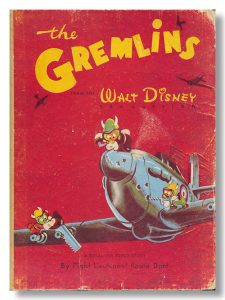 Through his sources, Roy learned that Warner Brothers, MGM, Universal and Columbia were all registering titles for future short cartoons using the word “gremlin”. Roy approached the Title Registration Committee to convince them that these new titles violated Disney’s claim to the word and previously registered title, but for what Roy later vaguely claimed were “technical reasons” the committee ruled against the Disney Studio.
Through his sources, Roy learned that Warner Brothers, MGM, Universal and Columbia were all registering titles for future short cartoons using the word “gremlin”. Roy approached the Title Registration Committee to convince them that these new titles violated Disney’s claim to the word and previously registered title, but for what Roy later vaguely claimed were “technical reasons” the committee ruled against the Disney Studio.
Since the Disney Studio had already invested up to $50,000 in their Gremlin feature, Roy leveraged his good will with the other studios to try to prevent them from producing gremlin animated shorts.
Walter Lantz who was working with Universal agreed to drop his planned cartoons on the subject and withdraw the titles for those proposed animated shorts. MGM’s cartoon producer Fred Quimby agreed to do the same and pledged his full cooperation.
Dave Fleischer, a former fierce competitor of the Disney Studio, was working at Columbia after having been ousted from his own studio by Paramount a year earlier, said he would try to cooperate but emphasized he did not have the final say in the matter.
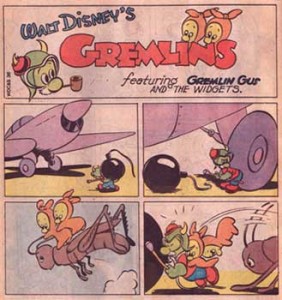 Despite Fleischer’s assurance, Roy found out someone at Columbia was still pushing for a gremlin cartoon.
Despite Fleischer’s assurance, Roy found out someone at Columbia was still pushing for a gremlin cartoon.
Roy wrote personally to Columbia studio president Harry Cohn on April 16, 1943: “Harry, you know Walt and me well enough to realize that we wouldn’t give two hoots about competition, short-subject to short-subject. But I am very worried when we start to make a feature that takes us at least a year to produce and costs us at least $600,000 to $800,000.
“I’m worried at the thought of having a property of this size undermined…so that is the reason I’m bothering you with this – to earnestly and seriously request that you persuade your cartoon department to drop the ‘Gremlin’ idea.”
B.B. Kahane, who became Vice President of Columbia in 1938, replied on behalf of Cohn that Columbia would not develop any cartoons about gremlins and they never did.
Two animated shorts were already too far into production when Roy O. Disney requested that Warner Brothers producer Leon Schlesinger not produce a gremlin short.
However, in an effort to help, Schlesinger did change the original titles to eliminate any mention of the word “gremlin”. Schlesinger apparently never told the animation department of the reason for changing the titles but they simply complied because he was the boss.
Falling Hare released October 30, 1943 was an eight minute Technicolor Warner Brothers animated short directed by Bob Clampett. Originally the cartoon was entitled Bugs Bunny and the Gremlin. The new title was a reference to Bugs falling to earth as a pun on the phrase “falling hair” indicating approaching baldness.
Bob Clampett was always a huge Disney fan but he never knew the reason Schlesinger requested the change in the titles to his two gremlin cartoons until 1976 when an interviewer told him about Roy Disney’s request.
The film’s story was unique because Bugs Bunny was the victim rather than the victor and the Oscar winning rabbit never says “What’s Up, Doc?” during the entire cartoon.
During World War II, on an Army Air Force airfield, Bugs is relaxing on top of a bomb waiting to be placed into a nearby bomber plane. He is reading a book entitled Victory Thru Hare Power (a reference to the 1942 book Victory Through Air Power by Major Alexander de Seversky that was the inspiration for a Disney propaganda film).
The book claims that gremlins wreck American planes through diabolical sabotage. Bugs dismisses such a claim until he sees one of the creatures striking a mallet on the head of bomb in hopes of detonating it.
Bugs chases the gremlin onto the bomber and finds himself locked inside as the creature gets the craft airborne. The plane finally goes into a tailspin with its wings ripping off and only the fuselage remaining as it plunges toward the ground. However, just before the impact, the plane sputters to a halt just a few feet from the earth.
Both Bugs and the gremlin tell the audience that they ran out of gas because of the “A card”, a rationing sticker indicating the lowest priority and limiting the amount of gas purchased to three to four gallons per week. It was a situation very familiar to an American wartime audience and resulted in a large final laugh of recognition as the final punch line.
The story was credited to Warren Foster with Rod Scribner as the lead animator.
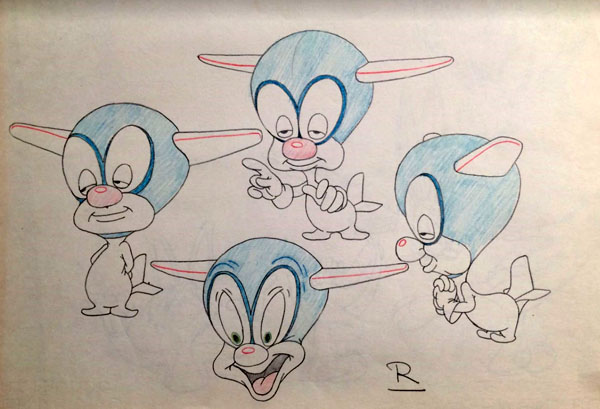
This particular Gremlin makes two reappearances in the Tiny Toon Adventures syndicated television series in the episodes “Journey to the Center of Acme Acres” where the gremlin appears (with several look-alikes) as the cause of earthquakes in Acme Acres and in “Night Ghoulery” menancing Plucky Duck in the segment “Gremlin on a Wing”, a parody of the iconic Twilight Zone television episode “Nightmare at 20,000 Feet” with William Shatner.
This gremlin also makes a brief cameo in an Animaniacs syndicated television series episode entitled “Plane Pals” as a passenger.
Russian Rhapsody released May 20, 1944 was a seven minute Technicolor Warner Brothers animated short directed by Bob Clampett. Originally, the cartoon was entitled Gremlins from the Kremlin and the animated short still includes a song by that name sung to the tunes of Ochi Chyornye (Dark Eyes) and Eh, Uchnem (Song of the Volga Boatmen).
 The film’s story is merely a simple framework on which to hang a non-stop series of visual gags in particular harrassing Adolf Hitler on a plane. Interestingly, the film makes clear that it is telling a story that is taking place in 1941 rather than 1944.
The film’s story is merely a simple framework on which to hang a non-stop series of visual gags in particular harrassing Adolf Hitler on a plane. Interestingly, the film makes clear that it is telling a story that is taking place in 1941 rather than 1944.
The story is officially credited to Lou Lilly but it is apparent that others supplied gags as well. Animation was done by Rod Scribner, Robert McKimson, Manny Gould and Art Davis.
Many of the gremlins are exaggerated caricatures of the Warner Bros. animation department staff including Chuck Jones (a small purple one), Bob Clampett (with pick axe), Friz Freleng (small green one with long pointed nose), Melvin “Tubby” Millar (with the tack on his head), Michael Sasanoff, Michael Maltese, Carl Stalling, Henry Binder (V-shaped black hair), John Burton and Ray Katz (being hit by Schlesinger gremlin) among others.
Even producer Leon Schlesinger appears as a gremlin who is shown tapping the heads off of rivets with a hammer as he’s being raised by a rope on a hook through the back of his clothes.
Because of its wartime references, especially its depiction of Hitler, this cartoon was rarely shown on television and now only in historical retrospectives.



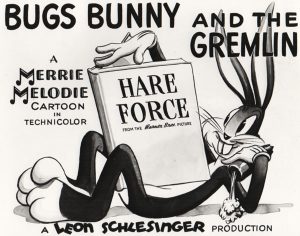
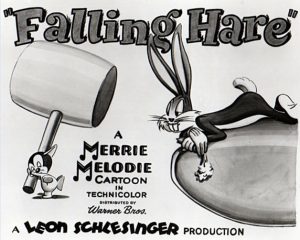
 Jim Korkis is an internationally respected animation historian who in recent years has devoted his attention to the many worlds of Disney. He was a columnist for a variety of animation magazines. With his former writing partner, John Cawley, he authored several animation related books including The Encyclopedia of Cartoon Superstars, How to Create Animation, Cartoon Confidential and Get Animated’s Animation Art Buyer’s Guide. He taught animation classes at the Disney Institute in Florida as well as instructing classes on acting and animation history for Disney Feature Animation: Florida.
Jim Korkis is an internationally respected animation historian who in recent years has devoted his attention to the many worlds of Disney. He was a columnist for a variety of animation magazines. With his former writing partner, John Cawley, he authored several animation related books including The Encyclopedia of Cartoon Superstars, How to Create Animation, Cartoon Confidential and Get Animated’s Animation Art Buyer’s Guide. He taught animation classes at the Disney Institute in Florida as well as instructing classes on acting and animation history for Disney Feature Animation: Florida.




















































The gremlins also made an appearance in “The Scare Up There”, an episode of “The Sylvester and Tweety Mysteries”, in which Granny and her pets take a 17-hour intercontinental flight to find out who’s been stealing the little packets of complimentary peanuts (spoiler: it was the Tasmanian Devil, disguised as a stewardess). Sylvester is the only one who sees them. These gremlins have little moustaches, making them look a little like Bob McKimson or Ub Iwerks.
Then there was Goody the Gremlin, a Casper knock-off who starred in a series of cartoons that Paramount made in the early ’60s. I guess Disney didn’t even try to stop that from happening.
It’s interesting to speculate what a Disney gremlin feature might have been like, but it would probably be a dated wartime curiosity like “Victory Through Air Power”, of little lasting value to the company. Maybe the characters could have been used in TV commercials for the AMC Gremlin in the ’70s. A gremlins ride at one of the theme parks, giving the effect that the whole thing was going to fall apart at any moment, would have been a terrible idea.
Two of my favorite cartoons.
Thanks for this.
The Disney gremlins were given a starring role in two Disney video games: Epic Mickey, and its sequel, Epic Mickey 2: The Power of Two. It would be nice to see them utilized in other places as well at some point.
I would LOVE to play that game. Danged if I don’t have a Wii.
Dark Horse put out a limited series comic book, supposed to follow the Disney/Roald Dahl version of gremlins.
The gremlin’s laugh in Falling Hare reminds me of Woody Woodpecker’s. Also, viewing that cartoon in the 21st century with the plane narrowly squeezing between two skyscrapers can’t help making one think of 9/11.
That is interesting your mind went that way. 9/11 did not cross my mind when watching this cartoon. Perhaps because I had seen it so many times while growing up.
The Gremlin’s laugh in “Falling Hare” is actually Benny Rubin’s “Yankee Doodle” laugh, which Benny started using in vaudeville and film appearances in the early 1930s.
Cool.
The Yankee Doodle laugh occurs several times in the 1933 Willie Whopper cartoon “Stratos Fear”. Interesting to learn of its vaudevillian origin.
It also occured in “Lil’Angil” (1936), Columbia’s only attempt of doing a “Krazy Kat” short in the style of George Harriman’s orginal comic strip.
There’s a difference in the laughs:
Woody: ooh-ooh-ah-ahh-ahh
Gremlin: eh-eh-eh-eh-eh-eh-eh-eh-eh-eh
Weird a crazy bunch of weirdos, aren’t we?
Paul’s thoughts are mine. It would just be a dated Disney feature, left to be a special feature on a double-feature DVD of Make Mine Music and Fun and Fancy Free, forever forgotten. Would probably be full of racial caricatures, and we’d have Leonard Maltin explain it to us.
Actually, I’m pretty sure it would be included as part of the “Walt Disney Treasures” series, not as a bonus feature on a regular DVD (really?).
And here, at the WWI Museum (New Orleans), they sell the (unseen Disney) gremlin stuffed animal in the gift shop!!!
Maybe Walt realized that making a feature about gremlins would be like making “The Seven Dwarfs and Snow White.”
Recall reading that Roald Dahl, author of the gremlins story Disney bought, later claimed he didn’t like the idea of a movie and quietly undercut Walt’s enthusiasm for it.